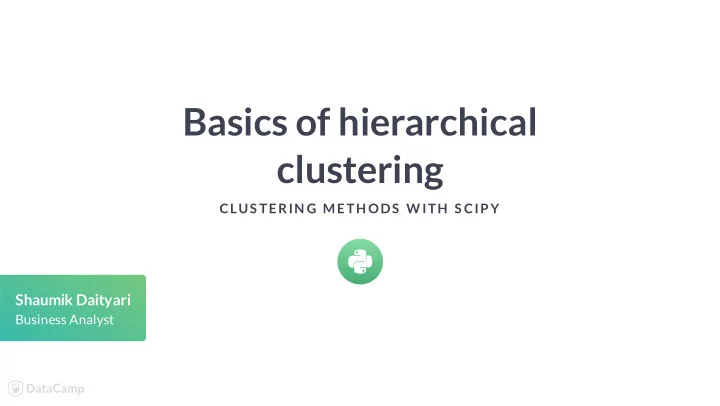

Basics of hierarchical clustering CLUS TERIN G METH ODS W ITH S CIP Y Shaumik Daityari Business Analyst
Creating a distance matrix using linkage scipy.cluster.hierarchy.linkage(observations, method='single', metric='euclidean', optimal_ordering=False ) method : how to calculate the proximity of clusters metric : distance metric optimal_ordering : order data points CLUSTERING METHODS WITH SCIPY
Which method should use? single: based on two closest objects complete: based on two farthest objects average: based on the arithmetic mean of all objects centroid: based on the geometric mean of all objects median: based on the median of all objects ward: based on the sum of squares CLUSTERING METHODS WITH SCIPY
Create cluster labels with fcluster scipy.cluster.hierarchy.fcluster(distance_matrix, num_clusters, criterion ) distance_matrix : output of linkage() method num_clusters : number of clusters criterion : how to decide thresholds to form clusters CLUSTERING METHODS WITH SCIPY
Hierarchical clustering with ward method CLUSTERING METHODS WITH SCIPY
Hierarchical clustering with single method CLUSTERING METHODS WITH SCIPY
Hierarchical clustering with complete method CLUSTERING METHODS WITH SCIPY
Final thoughts on selecting a method No one right method for all Need to carefully understand the distribution of data CLUSTERING METHODS WITH SCIPY
Let's try some exercises CLUS TERIN G METH ODS W ITH S CIP Y
Visualize clusters CLUS TERIN G METH ODS W ITH S CIP Y Shaumik Daityari Business Analyst
Why visualize clusters? Try to make sense of the clusters formed An additional step in validation of clusters Spot trends in data CLUSTERING METHODS WITH SCIPY
An introduction to seaborn seaborn : a Python data visualization library based on matplotlib Has better, easily modi�able aesthetics than matplotlib! Contains functions that make data visualization tasks easy in the context of data analytics Use case for clustering: hue parameter for plots CLUSTERING METHODS WITH SCIPY
Visualize clusters with matplotlib from matplotlib import pyplot as plt df = pd.DataFrame({'x': [2, 3, 5, 6, 2], 'y': [1, 1, 5, 5, 2], 'labels': ['A', 'A', 'B', 'B', 'A']}) colors = {'A':'red', 'B':'blue'} df.plot.scatter(x='x', y='y', c=df['labels'].apply(lambda x: colors[x])) plt.show() CLUSTERING METHODS WITH SCIPY
Visualize clusters with seaborn from matplotlib import pyplot as plt import seaborn as sns df = pd.DataFrame({'x': [2, 3, 5, 6, 2], 'y': [1, 1, 5, 5, 2], 'labels': ['A', 'A', 'B', 'B', 'A']}) sns.scatterplot(x='x', y='y', hue='labels', data=df) plt.show() CLUSTERING METHODS WITH SCIPY
Comparison of both methods of visualization MATPLOTLIB PLOT SEABORN PLOT CLUSTERING METHODS WITH SCIPY
Next up: Try some visualizations CLUS TERIN G METH ODS W ITH S CIP Y
How many clusters? CLUS TERIN G METH ODS W ITH S CIP Y Shaumik Daityari Business Analyst
Introduction to dendrograms Strategy till now - decide clusters on visual inspection Dendrograms help in showing progressions as clusters are merged A dendrogram is a branching diagram that demonstrates how each cluster is composed by branching out into its child nodes CLUSTERING METHODS WITH SCIPY
Create a dendrogram in SciPy from scipy.cluster.hierarchy import dendrogram Z = linkage(df[['x_whiten', 'y_whiten']], method='ward', metric='euclidean') dn = dendrogram(Z) plt.show() CLUSTERING METHODS WITH SCIPY
CLUSTERING METHODS WITH SCIPY
CLUSTERING METHODS WITH SCIPY
CLUSTERING METHODS WITH SCIPY
CLUSTERING METHODS WITH SCIPY
CLUSTERING METHODS WITH SCIPY
Next up - try some exercises CLUS TERIN G METH ODS W ITH S CIP Y
Limitations of hierarchical clustering CLUS TERIN G METH ODS W ITH S CIP Y Shaumik Daityari Business Analyst
Measuring speed in hierarchical clustering timeit module Measure the speed of .linkage() method Use randomly generated points Run various iterations to extrapolate CLUSTERING METHODS WITH SCIPY
Use of timeit module from scipy.cluster.hierarchy import linkage import pandas as pd import random, timeit points = 100 df = pd.DataFrame({'x': random.sample(range(0, points), points), 'y': random.sample(range(0, points), points)}) %timeit linkage(df[['x', 'y']], method = 'ward', metric = 'euclidean') 1.02 ms ± 133 µs per loop (mean ± std. dev. of 7 runs, 1000 loops each) CLUSTERING METHODS WITH SCIPY
Comparison of runtime of linkage method Increasing runtime with data points Quadratic increase of runtime Not feasible for large datasets CLUSTERING METHODS WITH SCIPY
Next up - exercises CLUS TERIN G METH ODS W ITH S CIP Y
Recommend
More recommend